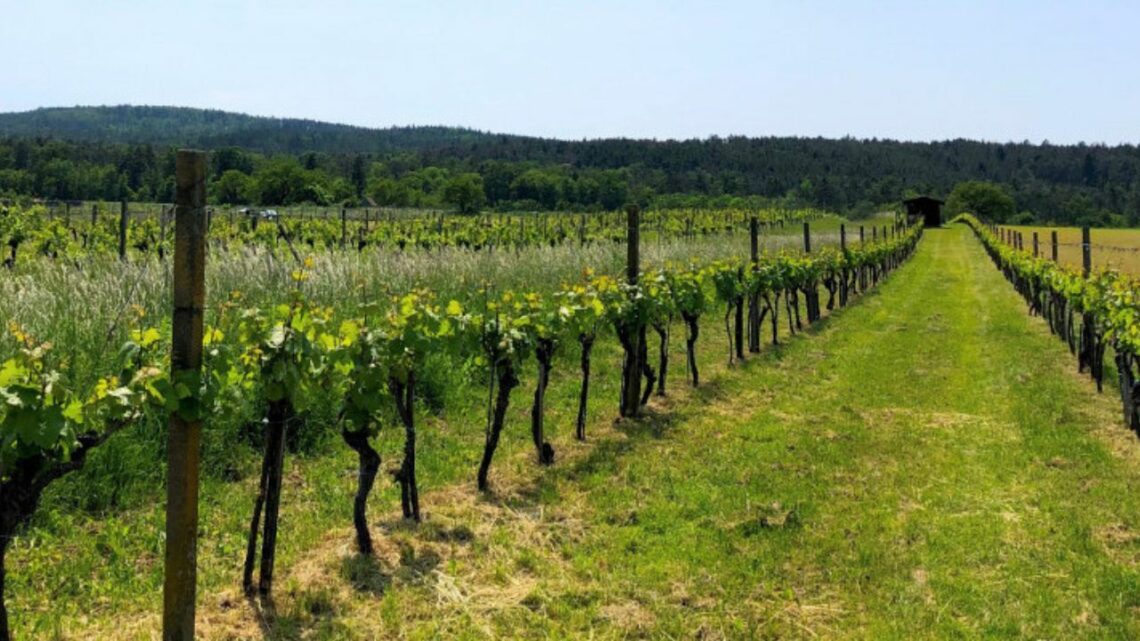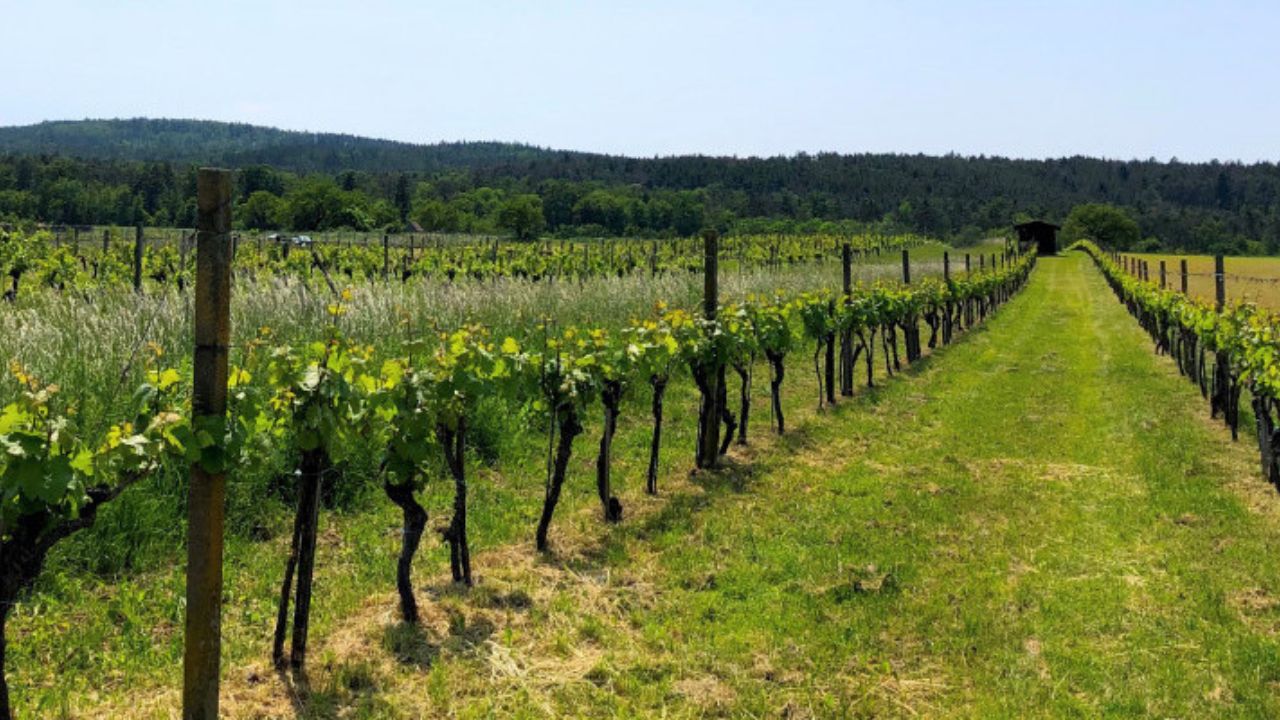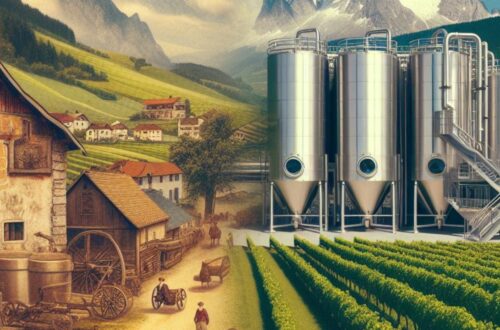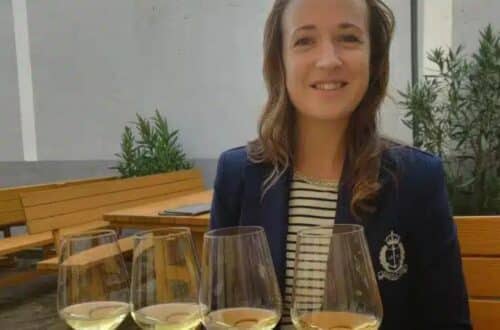
Leithaberg wines
The wine styles in Burgenland are diverse from red wine to which exceptional sweet wines. This is mainly due to Burgenland’s terroir.
For instance, the sweet wines are produced around the lake due to factors like shallow water, autumn mists, and noble rot..
However, the slopes of Leithaberg, Eisenberg, and Mittelburgenland, with their limestone, clay, and schist soils which provide good water retention and drainage offer ideal conditions for the production of red wines.
Mount Eisenberg, for instance, provides optimal conditions for elegant Blaufränkisch wines, while the Mittelburgenland area and the north of Rosalia yield exceptional Blaufränkisch wines known for their depth and length. The eastern slopes of the Leitha mountain offer a terroir suitable for complex white wines and Blaufränkisch. The Seewinkel area benefits from a special microclimate and is renowned for its sweet wines, particularly Welschriesling.
Leithaberg is a wine region in Burgenland, Austria, west of Neusiedlersee. It has diverse soils, including limestone, schist, gravel, loam, sand, and clay. The cooler climate leads to Blaufränkisch wines with higher acidity. The region grows several grape varieties, mainly Blaufränkisch, as well as Grüner Veltliner, Welschriesling, Pinot Blanc, Chardonnay, Zweigelt, St. Laurent, Merlot, Cabernet Sauvignon, and Syrah. Leithaberg DAC wines must be aged in oak. Notable wineries include Markus Altenburger, Birgit Braunstein, Feiler Artinger, Toni Hartl, Kollwetz, Leberl, Prieler, Heidi Schröck, Turner, Rosi Schuster, Erwin Tinhof, Ernst Triebaumer, and Robert Wenzel.
Leithaberg overall presentation
Leithaberg is a wine region located mostly west of the Neusiedlersee in Burgenland, Austria.
The soils of the slopes of the Leitha Mountain are rich in limestone, interspersed with crystalline schists and acidic gneiss, which makes it ideal for dry red wines.
The area is ideal for wine tourism. I would suggest you start by visiting its regional capital, Eisenstadt with its famous Esterhazy Castle. Stop then at Mörbisch with its lake festival, Sankt Margarethen with its music festival in the Römersteinbruch quarries, and Rust with its wine academy.
Terroir of Leithaberg: soil and climate
I’ve spoiled things a bit for you… As I wrote earlier, the hills are primarily composed of fossil limestone, but higher up, there are schist and gneiss formations.
ANECDOTE : Hans Nittnaus, a renowned winemaker, notes that Leithaberg has a cooler climate compared to the Neusiedlersee region across the lake, resulting in Blaufränkisch wines with slightly higher acidity.

The oldest rocks in the area are the acidic schists and gneisses of the Austro-Alpine region, which form the central part of the Leitha Mountain and are home to the highest vineyards, located between Breitenbrunn and Donnerskirchen, as well as some isolated vineyards around Eisenstadt and Oslip.
However, the most characteristic rock in the area is the Leitha limestone. Its origin dates back to calm and shallow waters of a warm sea that surrounded the Leitha Mountain 16 to 11 million years ago, providing optimal conditions for small reefs.
The Leitha limestone is a hard and light-colored limestone composed of algae and rich in remains of marine organisms such as shells, snails, and sharks.
It contrasts with the slightly older, quartz-rich and sandy gravel of the Rust chain.
Separated from the Leitha limestone by tectonic shifts, these two very different bedrocks coexist closely, creating acidic and limestone soils for vineyards.
In the lower-lying areas, the vineyards are established on loose loams, sands, and often limestone gravels of the Pannonian Basin, as well as on clays, lacustrine clays, and gravelly river sediments.
These are mostly well-drained soils which is great for red wines. If you want to know more about the impact of soil on wines, I wrote a whole post on it.
Grapes for Leithaberg wines
Leithaberg covers an area of 3,097 hectares and is known for producing wines from grape varieties such as Blaufränkisch mostly. They can also be blended with Zweigelt, St. Laurent, or Pinot Noir.
Seeing as Burgenland is the hottest wine region in Austria, this is where you will come across international grape varieties (which grow in warm climates) such as Merlot, Cabernet Sauvignon and Syrah.
Concerning the whites, you may come across are Grüner Veltliner, Welschriesling, Weissburgunder (Pinot Blanc), and Chardonnay.
Leithaberg DAC
The defined production area for the Leithaberg DAC appellation includes the administrative district of Eisenstadt and its surroundings, the free city of Freistadt Eisenberg, and the administrative municipalities of Jois and Winden.
The Leithaberg DAC appellation was launched in 2010. The DAC regulations require that at least 85% of the blend be made from Blaufränkisch, with no more than 15% of St. Laurent, Zweigelt, or Pinot Noir allowed. The wines must also be aged in oak.
For white wines, blends of Weissburgunder, Chardonnay, Neuburger, and Grüner Veltliner are allowed, and they can be aged in steel tanks or barrels.
Leithaberg DAC wines are always mineral and quite full-bodied (alcohol content ranging from 12.5% to 13.5% by volume, as indicated on the label).
The village of Rust, although within the DAC boundaries, does not include the Ausbruch wines, which fall under the broader Burgenland appellation. Ausbruch wines from Rust are highly regarded, with vines that were first planted 130 years ago.
ANECDOTE : Ausbruch, a sweet wine, has similarities to Trockenbeerenauslese (TBA) wines. Leading producers of Ausbruch, including Heidi Schröck, emphasize the minerality and saltiness in their wines due to the loamy sand soils with limestone and schist. They believe that the sweet wines from the eastern side of the lake tend to have more explosive tropical fruit flavors, as the grapes there ripen earlier. In 1991, a group of committed Ausbruch producers formed the Cercle Ruster Ausbruch to promote and defend the style of these exceptional wines.
Wineries in Leithaberg
Now, to the wineries! Here are some of the most famous wineries in Leithaberg where quality is usually constant.
Markus Altenburger took over the winery in 2012 and immediately made significant changes, reducing the yield by half. The flagship wine is called “Vom Kalk” (From the Limestone), emphasizing the importance of the region’s unique terroir. Their best vineyard is the exceptional Gritschenberg vineyard, which is subject to vintage variation (it means the wines quality level depends on the vintage). It was planted in the 1970s by Markus’ grandfather on limestone soil.
Birgit Braunstein has been practicing biodynamic viticulture since 2001 and is passionate about natural wines. Her Blaufränkisch is aged for 8 months in amphorae and then spends an additional 24 months in barrels. The St. Laurent from the Goldberg vineyard is known for its elegance.
Feiler Artinger is primarily known for its magnificent sweet wines, but their Blaufränkisch “Solitaire” is also excellent. His Ausbruch wines are made from Pinot, Welschriesling and Muskat Ottonel.
Toni Hartl produces the single vineyard Eisner, made from 40-year-old vines on iron-rich Leithaberg soils, which is regarded as a top-quality Blaufränkisch. The estate also produces great Chardonnay from Thenau, in the best years.
Kollwentz is THE great producer. They were the first estate to plant Cabernet Sauvignon in the region. Many of their vineyards are located on the southern slopes of the Leithaberg, with soils ranging from fossil limestone to deeper loam.
Their most famous white wine is Tatschler, made from Chardonnay vines planted in 1988 on slate and limestone soil, barrel-fermented, undergoing malolactic fermentation, and aged in oak for 15 months.
Another standout wine is “Gloria,” grown high on the Leithaberg on fossil limestone and aged in new barriques.
I love all of their Blaufränkisch wines including a blend of young Blaufränkisch and Zweigelt called Steinzeiler.
Prieler is the best-known estate in Schützen, with the family taking over the vineyard in 1972. They practice organic farming and are renowned for their exceptional Weissburgunder (Pinot Blanc) under the DAC Leithaberg appellation. Their Blaufränkisch wines are excellent, and the Goldberg vineyard, with its high slate content as well as clay and loam, produces wines with considerable structure and power.
Heidi Schrök took over the winery in 1983 and has been producing excellent Ausbruch wines since the 1993 vintage. These wines are blends of Welschriesling, Weissburgunder, and Gelber Muskateller.
Ernst Triebaumer (ET) produces iconic Blaufränkisch wines from the Mariental vineyard. They have initiated a project to increase the bee population and use sheep for green cover trimming. The cellars are powered by solar energy.
The Mariental vineyard, located north of Rust on limestone soils, features vines up to 60 years old. Another top site is the Oberer Wald vineyard.
The Sauvignon Blanc “Vogelsang” from ET is consistently good, and their superb Ausbruch wine is a blend of Chardonnay, Welschriesling, and Sauvignon Blanc.
Robert Wenzel is a highly traditional producer of Ausbruch wines. He makes them by adding 20% of fresh must of Trockenbeerenauslese (TBA) quality to the botrytized grapes, using must of the same variety as the Ausbruch fruit.
Wenzel has always sought to differentiate Ausbruch from TBA, particularly by fermenting the must to relatively high alcohol levels.
In 1984, he was one of the first in Burgenland to replant Furmint and collaborated with Tokaj’s master winemaker, Istvan Szepsy, to identify an ancient Tokaj strain, which he then planted in Rust in 2006. The estate produces three Furmint wines, with the standout being “Saz,” a blend of Furmint and Gelber Muskateller.
These wines are immensely complex, showcasing aromas of quince, peach, and mandarin, depending on the vintage, with fine acidity, a silky texture, and excellent length.
Conclusion : Leithaberg wines
Leithaberg is a wine region in Burgenland, Austria, located mostly west of the Neusiedlersee.
The terroir of Leithaberg is shaped by diverse soil compositions, with limestone being the most characteristic rock, along with schist and gravel. The vineyards also extend to lower-lying areas with loams, sands, and clay soils. The climate in Leithaberg is slightly cooler compared to the Neusiedlersee region, resulting in Blaufränkisch wines with higher acidity.
The region cultivates various grape varieties, including Blaufränkisch primarily, Grüner Veltliner, Welschriesling, Weissburgunder (Pinot Blanc), Chardonnay, Zweigelt, St. Laurent, Merlot, Cabernet Sauvignon, and Syrah The Leithaberg DAC appellation regulations require oak aging for the wines.
Notable wineries in Leithaberg include Markus Altenburger, Birgit Braunstein, Feiler Artinger, Toni Hartl, Kollwetz, Leberl, Prieler, Heidi Schröck, Turner, Rosi Schuster, Erwin Tinhof, Ernst Triebaumer (ET), and Robert Wenzel







